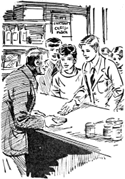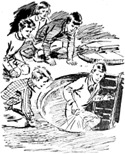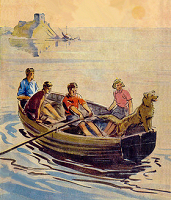

The Five pore over the map of the coast to find out where Demon's Rocks is situated.

Little Mischief the monkey is really a mischievous little monkey!

The Five buy sweets (or tobacco?) for the old man as a reward for telling such good tales!

A shaft leading down from the lighthouse. But the tunnels below are filled with water.

The police question nasty old Jacob, and he confesses to stealing a few things from the lighthouse.

Timmy wakes George one morning, and the Five find themselves trapped! Locked into the lighthouse! How will they ever signal for help? (Doh!)
Five Go to Demon's Rocks
Review by Keith Robinson (December 2, 2005)
In the Five's nineteenth adventure, Uncle Quentin has an important visitor coming to stay at Kirrin Cottage, a brilliant professor involved in great work. The problem is, Professor Hayling is arriving a week earlier than expected—and with his son Tinker! This is a problem for Aunt Fanny, because George, Anne, Julian and Dick are due to arrive on the same day, and there's just not enough room! To make matters worse, it seems Tinker is a pest of a boy, always zooming about the house pretending he's a car. And he has a monkey called Mischief. With five children and two animals in the house, it's inevitable that there's going to be a commotion of some kind every five minutes, and Quentin and the professor just CANNOT STAND THE NOISE!
It turns out that nine-year-old Tinker owns a lighthouse, given to him by his father after spending some time there on an important project. It's an old, disused lighthouse, standing empty and alone on Demon's Rocks about twenty miles along the coast from Kirrin. Naturally the Five love the idea of spending some time there—and getting out from under the angry scientists' feet! And so arrangements are made and the Five set off the next day.
I was puzzed to find that Julian himself makes all the arrangements regarding transport to the lighthouse. He hires a car and driver—a taxi?—and pays for it himself. Does Aunt Fanny or Uncle Quentin not have a car then? Or are they still using a pony and trap even in the sixties when this book was written? Even so, car or not, surely it should be up to Fanny to arrange this kind of thing.
The journey to, and arrival at the lighthouse is a very nice read. The lighthouse is well described and Tinker shows obvious enthusiasm for the fact that it belongs to him. And well he might! Even George, owner of an entire island, is impressed. Despite my reservations for any Famous Five book this late in the series, I did enjoy the first part of Five Go to Demon's Rocks more than I expected. There were a number of nagging doubts as the story progressed though. First on the list is that, once again, there's a crotchety old man with tales to tell, in this case Jeremiah Boogle, the great-grandad of the driver who brought the children to Demon's Rocks. How old is this man exactly? He's described as "very old," and he must be to be the great-grandad of the driver. There's a tiny discussion about this in the Talk About Blyton section; if the driver (George Jackson in my book, Gordon Jackson in the originals?) is 20, and his parents were 40, and his grandparents 60, then the great-grandad could be as "young" as 80... but I don't know. I guess we live in different times now, when couples don't routinely marry and have children by the time they're twenty!
Speaking of bloopers, I posted my own—about the Five going to buy the old man some sweets. The owner of the shop takes their money, says, "There you are" as if to pass the sweets over, then says he'll pass the sweets onto the old man next time he sees him. But later the Five hand over the sweet themselves! Suddenly, it all comes clear when I study the previous blooper about "Jeramiah Bougle" (completely different spelling); apparently "the tobacconist knows the brand name of the cigarettes when the Five buy him some." Clearly the publishers of the new edition decided that children shouldn't be buying tobacco for old men, so they changed it to sweets. This explains the bloopers where the shopkeeper says he'll pass on the "sweets" himself. A-ha! He would do if it was really tobacco he was selling! So I think it's a new edition publisher slip-up.
And on the subject of bloopers, is it by accident that the Five have somehow forgotten all about ship "wreckers" along the coasts (a major part of Five Go Down to the Sea)? And have the Five forgotten what it's like traversing an undersea tunnel, like the one George herself owns back at Kirrin? And come to mention it, it's extremely odd that the children never mention previous adventures and other treasure troves they've happened across. Did they forget their last adventure at Finniston Farm, for instance? I should think they're all very rich by now, with the rewards from all those treasures they keep finding! In reading this book I came to the conclusion that Blyton's failure to mention previous adventures is not by error—it was deliberate. I see a number of the last few books as variations on a single theme, almost as though Blyton were so taken by the idea of tunnels and treasure that she just couldn't stay away. Or, if I didn't know better, I'd think she had written the treasure-trail story in several different forms to see which would work best, planning to release only one of them!
So despite enjoying the first part of the book, I groaned very loudly when a) it became apparent that there was an old man with tales to tell, and b) it turned out there might be some treasure hidden away in the tunnels somewhere. And another similarity with other books: wherever the children stay, it seems the secret passages always have one "known" end (down some caves, or a castle basement, or an archeological dig) and one end that's "lost" (under the lighthouse, below the old chapel, or under a heavy stone by a stream). The Five always luck out and beat the baddies to the treasure because they manage to uncover the "lost" end of the passage. In Five Go To Demon's Rock's it takes an extraordinary amount of time for the children to figure out that the shaft leading down from the bottom of the lighthouse is, in fact, the other end of the tunnel they'd explored earlier. Come on, kids—buck up!
But what made me groan loudest, I think, was the way in which the treasure was found. Yet again an animal gets lost in some tunnels and returns with—you guessed it!—a shiny object. "What is it? Why, it looks like a gold coin!"
It's not all bad though. In fact I enjoyed Demon's Rocks more than I should have, considering the done-to-death story and oh-so-convenient plot devices. I don't know what made this one stand taller than Secret Trail or Finniston Farm, but it did—maybe because lighthouses naturally stand taller than their neighbors? I loved the whole lighthouse experience more than anything else, and would have enjoyed the story a whole lot more if it were a tale of kidnappers or burglars or something equally sinister and dangerous—even ghostly lights or something—instead of yet another tale of tunnels and hidden treasure. But at least in this book it's (almost) forgivable that no one has come across the treasure before; I won't go into details, but the reason it's been missing until now is vaguely plausible if you forgive the incredible coincidence that it's the Five who come across it yet again.
So, a pattern has emerged. The early Five books were individual and mostly unique stories where characters and overall arcs progressed through the series. The later Five books are individual but in no way unique, and previous stories are virtually erased from memory. By the last third of the twenty-one-book series, Blyton was writing single read-'em-anytime books—and who could blame her, with the Five inexplicably frozen at the ages of ten to thirteen or whatever they are. I have a new theory: somewhere towards the end of the series the time/space continuum split and the Five had the same adventure over and over, but simultaneously in multiple parallel universes, with just a few tiny details altered here and there. It explains everything! I just wish Enid Blyton could have included a foreward in each book:
Dear readers. Previously you read how the Five went down to the sea and had an exciting adventure involving secret passages and hidden treasure. But what would have happened if the Five hadn't decided to go down to the sea but went to stay at a riding school instead? Well, don't worry, children—they still would have had an exciting time! Read on to see how things MIGHT have been...
Five Go to Demon's Rocks
Review by Heather in Australia (January 12, 2006)Very early in this book we meet Tinker, a boy whose real name even his own inventor father can't remember (this struck me as a little strange, but I guess it goes with the professor's absent-mindedness). He's called Tinker for his love of cars, and the children take an instant dislike to his childish pretending and rude manner. His very Miranda-like monkey named Mischief is a lovely addition, a little different to dear old Timmy.
Things begin to get exciting when the five along with Tinker and Mischief go to stay at Tinker's lighthouse situated on the aptly-named Demon's Rocks. After hearing stories of evil ship wreckers, hidden treasure and family rivalry told by an aged seaman the children of course feel compelled to investigate the aptly named wreckers' caves.
After an interesting beginning with the collision of the children, Uncle Quentin, Tinker and his father (yet another grumpy scientist), the story becomes quite tame as the children enjoy ice creams, shopping and sightseeing. The interesting lighthouse is a welcome addition to the mystery's pre-amble, and it takes the focus off the relative inactivity. But it very quickly takes some quite frightening turns when the lighthouse is burgled and the key stolen. For once the children go to the friendly policeman, who continuously addresses Julian as "Sir" and is very helpful, professional and efficient (unlike other Blytonian policemen we all know). The undersea tunnels are very reminiscent of so many others, from the Adventure and Adventurous Four series especially, and also some in the preceding Five books. But exciting nonetheless, especially seeing as these ones purportedly hold ancient treasures (what Blytonian undersea tunnels don't?). For once Blyton's recycling of plots and landscape is eclipsed by the story—this time it really all fits well together, and the plot is very well organised and believable. Except for the obligatory finding-of-treasure and bad-guys-being-caught the story isn't totally predictable, either.
There are enough terrifying moments to keep you on the edge of your seat, and a cliffhanger (literally) towards the end when Julian is almost swept into the raging sea. All this really does make for a very worthy Famous Five adventure, and a welcome change after some very weak books in the series.


